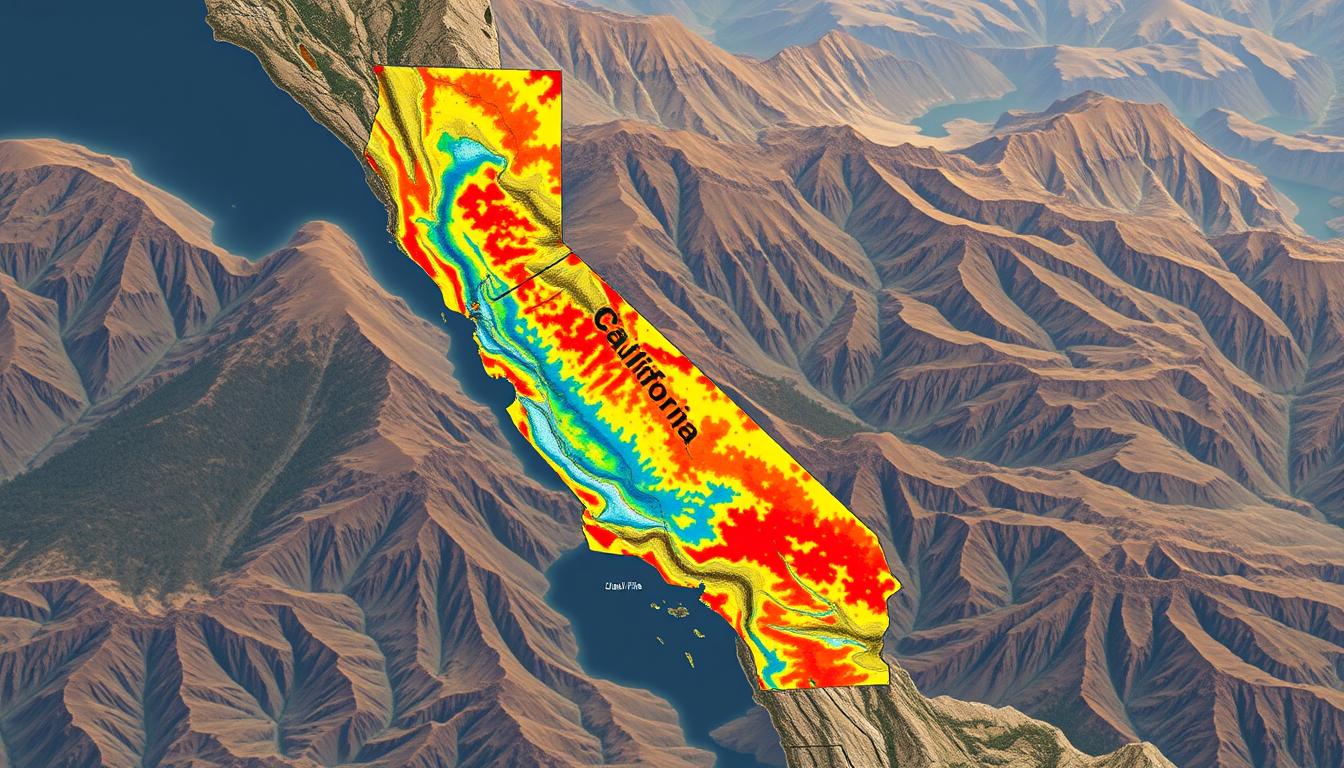California has battled wildfires for years, especially during the hot, dry months. In 2023, there were 7,127 wildfires, burning about 324,917 acres. The Frontline Wildfire Defense App offers real-time updates to help homeowners.
This california fires map shows active fires, fire perimeters, and hotspots. It helps residents keep an eye on threats to their homes. The california wildfires map improves preparedness and community response to fire risks.
Key Takeaways
- California faces increasing wildfire incidents annually, with over 7,000 reported in 2023.
- Real-time tracking through digital tools is crucial for effective risk management.
- The interactive map provides essential data for residents in fire-prone areas.
- Understanding the dynamics of wildfires can lead to better preparedness strategies.
- Monitoring current conditions aids in creating safe evacuation plans.
Understanding California’s Wildfire History
California’s wildfire history is marked by devastating fires that have changed the state’s landscape. These fires have affected many communities. From the first wildfire in 1889 to recent major fires, the trend shows more intense and frequent fires.
Major Historic Fires
The August Complex Fire in 2020 is a major example, burning over 1 million acres and destroying 935 structures. The Camp Fire in 2018 was the deadliest, taking 85 lives. Since 1932, fires like the Matilija Fire have burned around 220,000 acres, showing California’s long fight against wildfires.
Patterns of Intensity and Frequency
In the last five years, 50% of California’s biggest fires have happened. This rise is due to warmer temperatures, drought, and strong winds. The growing number and size of wildfires raise concerns about California’s climate and how to prepare for the future.
Impact on Communities
Wildfires do more than just damage property. They disrupt lives, force families to leave their homes, and harm air quality. This leads to health problems for those living nearby. In recent years, over 175,000 people have been displaced by wildfires, showing how deeply these disasters affect California’s residents.
How to Use the Interactive California Fires Map
The interactive California fires map is a key tool for many. It helps residents, first responders, and emergency teams during wildfires. It offers real-time data and features to navigate fire information effectively.
Features of the Map
The map has many features that make it useful. Some key ones include:
- Fire incident updates: It keeps you updated on fire activities.
- Perimeters: Fires are shown with red overlays for easy tracking.
- Thermal hotspots: Bright red dots show areas with high heat.
- Evacuation orders: Alerts on evacuation zones help keep communities safe.
- Smoke advisories: Updates on air quality help protect health.
Navigating Different Layers
Users can choose different layers on the map. This gives a full view of fire impacts. Layers include:
- Active fires: Shows current fire locations in California.
- Map saturation: Shows smoke density, using data from AirNow.
- Wind patterns: Windy.com data shows how weather affects fires.
- Community contributions: Local volunteers add to the map’s accuracy.
Zooming In for Detailed Views
Zooming in gives a detailed view of wildfire areas. This is crucial for:
- Understanding local impacts: See fire threats to nearby structures.
- Assessing safety zones: Find safe places and evacuation routes.
- Engaging community resources: Locate help centers and local agency assistance.
| Feature | Description | Updates Frequency |
|---|---|---|
| Fire Perimeter Data | Visual representation of fire boundaries | Every 12 hours |
| Hot Spot Data | Heat points indicating active fires | Twice daily |
| Air Quality Information | Health-related smoking conditions | Real-time updates |
| Wind Patterns | Forecasted wind conditions affecting fire | Real-time updates |
Current Wildfire Status in California
California is facing a serious wildfire situation, with many fires reported across the state. The current california fires map shows both active and contained fires. It’s crucial for everyone to keep up with cal fire updates to know the wildfire containment status.
Active Fires
In the Los Angeles area, five big wildfires are burning. The Palisades Fire has burned over 17,000 acres. The Eaton Fire has grown to at least 10,600 acres quickly. Wind gusts over 90 mph are making these fires very dangerous for communities.
Contained Fires
The Woodley Fire is fully contained and didn’t require evacuations, despite strong winds. Some fires are being managed well, giving relief to areas and their people.
Fire Projections
Cal Fire warns of ongoing risks due to wet winter vegetation growth. This may lead to more wildfires in the hotter months. People are advised to stay alert to fire threats and follow evacuation orders, as conditions can change fast.
| Fire Name | Acres Burned | Containment Status | Evacuation Orders |
|---|---|---|---|
| Palisades Fire | 17,000+ | Active | Yes |
| Eaton Fire | 10,600+ | Active | Yes |
| Hurst Fire | 850 | 10% Contained | Yes |
| Woodley Fire | Contained | Fully Contained | No |
Resources for Staying Informed About Wildfires
It’s crucial to stay informed during wildfire season. Residents can find many resources for wildfire information. This helps them get updates quickly. We’ll look at different platforms for california fire alerts and wildfire updates.
Local News Outlets
Local news outlets are key for wildfire coverage. They report on fire conditions, evacuation orders, and safety tips. Reliable news stations update the public through broadcasts and websites.
Signing up for alerts from these outlets keeps residents informed. This is especially important for local situations that might affect them.
Government Websites
Government websites like Cal Fire and the Statewide Fire Information page are vital. They offer official updates on active fires. This includes fire perimeter data updated every 12 hours.
They also show “hot spot” data, updated twice daily. These resources provide accurate and timely alerts about fires and evacuations.
Social Media Updates
Social media is now a key way to get wildfire updates. Twitter, for example, lets users follow official accounts for real-time info. But, be careful of non-government sources.
Apps like Breezometer give air quality details. Genasys Protect provides safety info during emergencies. Using these platforms helps raise community awareness and quickens response times.
| Resource Type | Examples | Features |
|---|---|---|
| Local News Outlets | ABC News, CBS Local | Real-time coverage, local alerts, community updates |
| Government Websites | Cal Fire, Statewide Fire Information | Official updates, fire perimeter and hot spot data |
| Social Media Platforms | Twitter, Facebook | Real-time updates, sharing of information, community engagement |
| Smartphone Apps | Breezometer, Genasys Protect | Air quality tracking, notification of evacuation orders |
Using these resources well can greatly help during wildfire season. By staying updated through local news, government sites, and social media, residents can quickly respond to changing situations. This ensures their safety and that of their loved ones.
Tips for Wildfire Preparedness
Getting ready for a wildfire means planning carefully. A good emergency plan can make your community and family safer. It’s important to know when to leave, what to take, and the best ways to get out quickly.
Creating an Emergency Plan
Start your emergency plan with family talks. Make sure everyone knows what to do if a fire happens. Pick meeting spots and ways to stay in touch if you’re separated.
Studies show families with plans can leave 35% faster than those without.
Essential Supplies to Have
Having the right supplies is key to staying safe during wildfires. Your evacuation kit should have:
- Medications and first-aid supplies
- Water and non-perishable food
- Flashlights and batteries
- Important documents (IDs, insurance)
- A fully charged mobile phone with backup power
Keep your supplies up to date and make sure everyone knows where the kit is. Homes that are ready see a 50% better chance of surviving wildfires.
Evacuation Routes to Consider
Knowing your evacuation routes is crucial. Sadly, 40% of people don’t know their community’s paths, leading to delays. Use local resources to find safe routes, considering road closures or dangers.
Talking about these routes often helps everyone move faster when it’s time to leave.
The Impact of Wildfires on the Environment
Wildfires are a big threat to our environment. They cause a lot of damage that goes beyond just burning down buildings. The air quality in areas where wildfires happen gets really bad, which can make people sick.
Wildfires also hurt wildlife by destroying their homes. This makes many animals lose their places to live and find food. It also makes it harder for different species to live together in balance.
After wildfires, the soil and water get damaged too. This makes it hard for plants and animals to survive. It shows how wildfires can harm our environment for a long time.
Effects on Air Quality
Wildfires make the air very bad to breathe. The smoke from fires has harmful particles that can make people’s lungs hurt. These tiny particles, called PM2.5, are especially dangerous.
They can make breathing problems worse and even cause new health issues. It’s very important to stay away from smoke when wildfires are happening.
Wildlife and Habitat Loss
Wildfires destroy homes and food for animals. This can happen very quickly, leaving animals without a place to live. It’s a big problem for many species.
Some animals might even disappear forever because of wildfires. Losing animals and their homes makes it harder for nature to stay healthy and strong.
Soil and Water Impact
Wildfires also hurt the soil and water. Ash and debris from fires can make water dirty. This is bad for people and animals who drink it.
Soil erosion and changes in rivers and streams are other problems. These issues show that wildfires keep causing problems even after they’re gone. It’s a big challenge for our environment.
Community Response to Wildfire Threats
Communities facing wildfires are coming together to stay safe. They are taking steps to protect their neighborhoods. Support networks and local efforts are key in this fight.
Neighborhood watch programs and volunteer firefighting are crucial. They help communities respond to wildfires better.
Neighborhood Watch Programs
Neighborhood watch programs teach residents to watch out for each other. They learn about fire prevention. This makes everyone responsible for safety.
Members work together to keep their homes safe. They stay alert during fire seasons. This teamwork helps everyone get out quickly and safely.
Volunteer Firefighting Efforts
In fire-prone areas, volunteer firefighters are a big help. They help when the regular fire department is busy. They get trained to fight fires well.
These volunteers are a big support. They help quickly when fires start. They make sure the community can act fast.
Local Fire Departments’ Role
Local fire departments are key in fighting wildfires. They teach communities about fire safety. They show how to evacuate and keep homes safe.
They work with residents and volunteers. This teamwork makes fighting wildfires more effective. It helps keep everyone safe.
Technology and Innovation in Wildfire Management
The way we manage wildfires is changing fast. New technology and ideas are helping us fight fires better. Technology in wildfire management is key to saving lives and property.
Drones and Aerial Firefighting
Drones are helping a lot in fighting wildfires. They give a bird’s eye view of fires. This helps teams decide where to send help.
Private companies like Coulson Aviation use special helicopters. They can drop water right on the fire. This makes aerial firefighting more effective.
Data Analytics for Fire Prediction
Data analytics are crucial for predicting wildfires. They use algorithms to forecast fire spread and intensity. This helps teams act fast.
In Orange County, a small fire was quickly put out. This shows how firefighting innovation is changing the game.
Advancements in Firefighting Equipment
New equipment is making firefighting better. The US Forest Service uses air tankers that can carry a lot of fire retardant. This helps fight fires more efficiently.
But, old methods like hoses and buckets are still used. This mix of new and old shows how firefighting is evolving. It prepares responders for today’s challenges.
Future Outlook for California Fires
The future of California wildfires looks complex, shaped by climate change. Rising temperatures and dry conditions mean more frequent and intense fires. Since 2001, U.S. wildfires have doubled in frequency, showing climate’s big impact.
Experts warn that these damaging trends could keep going. It’s crucial for communities at risk to take action.
Climate Change Considerations
California’s climate is changing, making wildfires more likely. Dry periods, high temperatures, and strong winds have been devastating. Winter fires are now more common, the worst in over 40 years.
As climate change evolves, California’s fire season is becoming year-round. This calls for a new approach to community preparedness.
Legislative Measures for Fire Safety
Lawmakers are focusing on fire safety laws to protect communities. New building codes and land management policies aim to reduce fire risks. They also help in responding to wildfires more effectively.
These efforts are vital for safeguarding vulnerable areas. Without them, damage could reach $57 billion.
Community Resilience Building
Building community resilience is key to facing wildfire risks. Programs focusing on preparation, resilience, and recovery are essential. They help communities withstand wildfires.
By improving local preparedness and encouraging proactive steps, communities can stay safe. This is crucial in California’s unpredictable climate.




